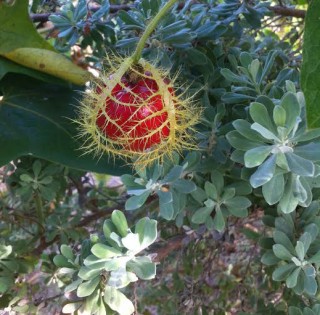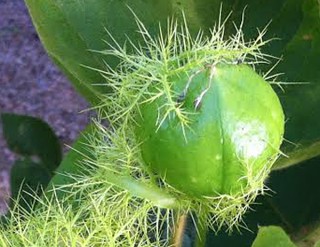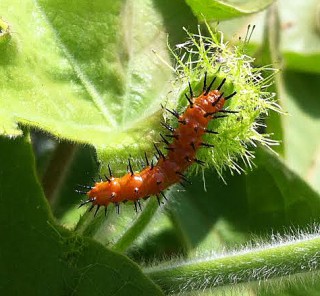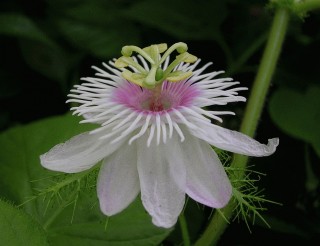Passionflower blossoms are structurally unique. You can see why they are said to symbolize the Passion of Christ. The ten petals represent the ten faithful apostles, the filament ring is the crown of thorns, the five stamens are for the five wounds, and the three-part pistil represents the three nails. Wikimedia Commons Photo.
08/08/2015 – Passionflower: Plant of Many Faces
On first seeing the fuzzy vine in the Butterfly Garden, I assumed it was something we planted. But as it grew and covered over the cenizo, I realized it was probably a “volunteer” and likely a native species at that. It was thriving, not just surviving, in the hot, dry conditions of a south Texas August. Even with only minimal supplemental watering, it was flowering and setting fruit. This plant had to have been “born and bred” here!

A ripe Passiflora foetida fruit is still surrounded by its bracts. This one is bright red, but some fruits are yellow, or yellow flecked with red. The fruits are edible and considered quite tasty. Karen Benson Photo.

The flowers and developing fruit of Passiflora foetida are protected by finely divided bracts. These bracts exude a sticky substance that traps insects. The substance also contains digestive enzymes. Does the plant get any nourishment from these digested insects? Karen Benson Photo.
The first flower I found on the vine convinced me it was a passionflower. All the passionflower species (and there are about 500 in the American tropics) have these distinctive flowers. They are so special that they have become the stuff of legends.
The passionflower legend is based on the Passion and Crucifixion of Jesus Christ. According to the legend, the plant parts are symbols of the scourging, the crown of thorns, three nails and the five wounds of Jesus. The pointed tips of the vine’s leaves are symbolic of the Holy Lance that pierced Christ’s side. The tendrils, which allow the vine to climb, look a bit like whips and are symbols for the flagellation. The ten petals and sepals represent the twelve apostles of Christ (minus Judas, the betrayer, and Paul, the denier). Above the petals in the passionflower is a ring of filaments, as many as a hundred in some species. This ring represents the crown of thorns. The chalice-shaped ovary symbolizes the Holy Grail and the three stigmata at the top of the ovary are said to be for the three nails with which Jesus was nailed to the cross. The five stamens represent the five wounds.

This Gulf Fritillary caterpillar is feeding on the leaves of a native south Texas passionflower vine. It will soon turn into beautiful butterfly. Karen Benson Photo.
How did such a legend get started? In the 15th and 16th centuries, Spain conquered much of the New World. Many of their conquests were of peoples in the tropics. Spanish missionaries arrived to help Christianize these native peoples. Being learned men, the priests and monks took note of the plants and animals in the New World, and sent back descriptions and drawings of the wondrous things they saw. One such plant was the passionflower vine.
In 1609, a monastic scholar in Rome, Jacomo Bosio, heard accounts of the marvelous flower of New Spain. He was working on his treatise on the Cross of Calvary at the time. Bosio felt it was his duty to present this “Flos Passionis” flower story to the world as a sign of a most wondrous example of the Crucifixion, discovered in the forest of the New World. The lovely flower had its own appeal, but complemented by the legend promulgated by the monks, it quickly became famous as the passionflower.
Back in its native tropics, the passionflower vine is better known for its fruit. The passion fruits are capsules of pulp-covered seeds with a taste reminiscent of “tropical pineapple and crisp white grapes.” The pulp is also said to produce a delightfully refreshing drink.
The fruits on the vine I saw in the Butterfly Garden were about an inch in diameter. However, they were mostly filled with air. The seeds inside did have a slight layer of blueish white pulp, but not enough to eat or make a juice out of. Maybe it was just past its prime.
The wild passionflower of south Texas is a species known as Passiflora foetida. It gets its name “foetida” because the crushed leaves are stinky. I crushed a few leaves and did not smell anything. Internet sources are divided in their observation of P. foetida’s stinkiness. Some said it was very pungent, with an odor like that of billy goats; others claimed it had no odor at all. I think it must vary from plant to plant (or from nose to nose?).
Perhaps the most fascinating thing I read about Passiflora foetida is that the lacy-looking bracts surrounding the flower and fruit are able to trap insects. The bracts exude a sticky substance that also contains digestive enzymes. This substance protects the flowers and young fruits. And the plant may also absorb the digested insects as a plant food. Whether or not it actually gets nourishment from its prey is still uncertain, but this passionflower is “currently considered a protocarnivorous” plant. It is rather like a sundew or Venus’ Flytrap in the making!
Butterfly lovers have good reason to grow passionflowers. They are the larval food plant for several tropical Heliconian butterflies: the Gulf Fritillary, the Julia, and the Zebra Longwing. These butterflies also go to passionflowers for their nectar. This means you can see both adults at the blossoms and the strikingly-colored caterpillars feeding on the leaves.
So whether you decide to grow passionflowers for their beautiful flowers, their religious symbolism, their tasty fruit, their appeal to butterflies, or for their possibly carnivorous natures, you can’t go wrong. Consider growing our native Passiflora foetida. It can take the heat, the drought, and almost anything south Texas throws at it. And it is still looks good!
If you would like to offer comments, please click through to the discussion page

